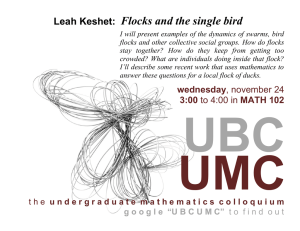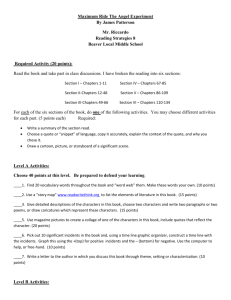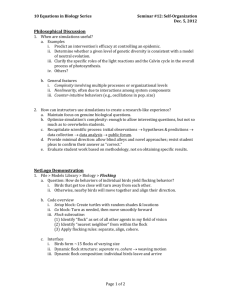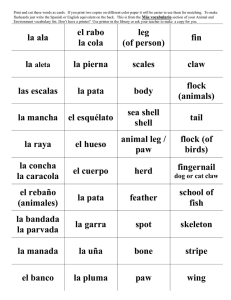COMPOSITION AND TEMPORAL VARIATION OF FLOCKS
advertisement
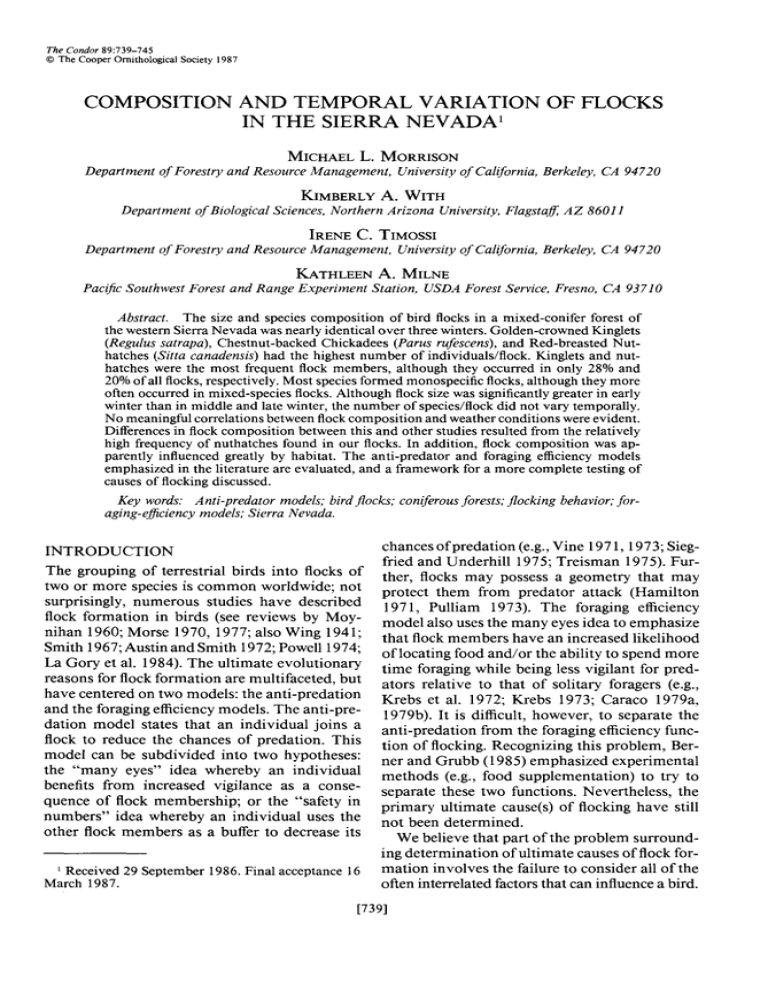
The Condor89:739-145 0 The CooperOmthological Society1987 COMPOSITION AND TEMPORAL VARIATION IN THE SIERRA NEVADA’ OF FLOCKS MICHAEL L. MORRISON Department of Forestryand ResourceManagement, Universityof Caltfornia, Berkeley,CA 94720 KIMBERLY A. WITH Department of BiologicalSciences,Northern Arizona University,Flagstag AZ 8601 I IRENE C. TIMOSSI Department of Forestryand ResourceManagement, Universityof Caltfornia, Berkeley,CA 94720 KATHLEEN A. MILNE Pacific SouthwestForest and Range Experiment Station, USDA Forest Service,Fresno, CA 93710 Abstract. The size and speciescomposition of bird flocks in a mixed-conifer forest of the westernSierra Nevada was nearly identical over three winters. Golden-crowned Kinglets (Regulussatrapa), Chestnut-backedChickadees(Parus rufescens),and Red-breasted Nuthatches (Sitta canadensis)had the highest number of individuals/flock. Kindets and nuthatches were the most frequent flockmembers, although they occurred in only 28% and 20% of all flocks,respectively.Most speciesformed monospecificflocks,althoughthey more often occurredin mixed-speciesflocks. Although flock size was significantlygreaterin early winter than in middle and late winter, the number of species/flockdid not vary temporally. No meaningfulcorrelationsbetweenflock composition and weather conditionswere evident. Differencesin flock composition between this and other studiesresultedfrom the relatively high frequency of nuthatchesfound in our flocks. In addition, flock composition was apparently influenced greatly by habitat. The anti-predator and foraging efficiency models emphasizedin the literature are evaluated, and a framework for a more complete testingof causesof flocking discussed. forests;flocking behavior;forKey words: Anti-predator models;bird flocks:contferous aging-ejiciencymodels;Sierra Nevada. INTRODUCTION The grouping of terrestrial birds into flocks of two or more species is common worldwide; not surprisingly, numerous studies have described flock formation in birds (see reviews by Moynihan 1960; Morse 1970, 1977; also Wing 1941; Smith 1967; Austin and Smith 1972; Powell 1974; La Gory et al. 1984). The ultimate evolutionary reasons for flock formation are multifaceted, but have centered on two models: the anti-predation and the foraging efficiency models. The anti-predation model states that an individual joins a flock to reduce the chances of predation. This model can be subdivided into two hypotheses: the “many eyes” idea whereby an individual benefits from increased vigilance as a consequence of flock membership; or the “safety in numbers” idea whereby an individual uses the other flock members as a buffer to decrease its ’ Received 29 September 1986. Final acceptance16 March 1987. chancesofpredation (e.g., Vine 1971, 1973; Siegfried and Underhill 1975; Treisman 1975). Further, flocks may possess a geometry that may protect them from predator attack (Hamilton 1971, Pulliam 1973). The foraging efficiency model also uses the many eyes idea to emphasize that flock members have an increased likelihood of locating food and/or the ability to spend more time foraging while being less vigilant for predators relative to that of solitary foragers (e.g., Krebs et al. 1972; Krebs 1973; Caraco 1979a, 1979b). It is difficult, however, to separate the anti-predation from the foraging efficiency function of flocking. Recognizing this problem, Berner and Grubb (1985) emphasized experimental methods (e.g., food supplementation) to try to separate these two functions. Nevertheless, the primary ultimate cause(s) of flocking have still not been determined. We believe that part of the problem surrounding determination of ultimate causes of flock formation involves the failure to consider all of the often interrelated factors that can influence a bird. 17391 140 MICHAEL L. MORRISON ET AL. Little attention has been given, for example, to temporal variations in flock size and composition, or to the influence of weather on flocks. Further, other processesinfluencing birds, such as mate selection, seasonal changes in habitat requirements,and physiologicalconstraints,have not been adequately considered. These considerations are important in understanding the mechanisms controlling flock formation. Our objectives were to describe flock size and composition within and between years during three winters in the western Sierra Nevada, with attention given to the frequency of occurrenceof speciesin flocks. We also analyzed the possible influence of environmental conditions on flocking behavior, and evaluated results in light of current models of flock formation in birds. We emphasize that the nonexperimental nature of our study renders our examination exploratory and hypothesis generating, rather than hypothesis testing. STUDY AREA AND METHODS The study area was the 1,200-ha Blodgett Forest Research Station (University of California, Berkeley), El Dorado County, California. The forest is between 1,200 and 1,500 m elevation in the mixed-conifer zone (Griffin and Critchfield 1972) of the western Sierra Nevada, and is predominated by mature standsof various mixtures of incense cedar (Calocedrusdecurrens),white fir (Abiesconcolor),ponderosa(Pinusponderosa)and sugar (P. lambertiana) pines, Douglas-fir (Pseudotsuga menziesii), and California black oak (Quercuskelloggii). The climate is characterized by dry, warm summers and mild, wet winters. Average precipitation is about 168 cm/year with a 22 year range of 58-274 cm. Snow is common from November to April, averaging about 254 cm/year. Average daily maximum temperatures range from 9°C during winter to 27°C during summer (R. C. Heald, pers. comm. from unpubl. data on file at Blodgett Forest). Vegetation of the forestwas describedby Airola and Barrett (1985) and Morrison et al. (1985, 1986). Becauseof a change in study design, two different methods were used to record bird flocks; these methods are outlined below, and further details regarding counting methods and overall study designwere given by Morrison et al. (1985, 1986). During winter (late October to mid-March) 1982-1983 and 1983-1984, birds were counted for 5 min in 30-m-radius plots at 40 points in the forest; each point was visited on four momings during each winter. Each point was at least 200 m from the next nearestpoint. All birds were counted, and those in flocks (defined as a group of two or more individuals of the same or a different speciesapparently moving together) were noted. All members of a flock were counted when any part of the flock entered a count radius. Because flocks were seldom recorded using this method, and flock size did not vary (P > 0.1, t-test) between these winters, we combined data to provide larger sample sizes for comparison with data collected during 1984-1985 (see below). This method totalled 27 hr of actual recording time during the two winters. During winter 1984-1985, several different areas (totaling about 100 ha) were chosen for study. Rather than using specificcounting points, observerssystematicallywalked through the areas throughout the day, recording all birds seen and noting flock composition. Possibly the same individuals or flocks were counted repeatedly; however, our intent was to determine average flocking characteristics and not the abundance of birds. About 120 hr during 22 days were spent in observing flocking behavior during winter 1984-1985. Analysis of intraseasonal aspectsof flock composition were restricted to 1984-1985 becauseof the larger sample sizes. All analyses were performed using the SPSSX (SPSS 1983) computer package. RESULTS FLOCK SIZE AND COMPOSITION The overall size and composition of mixedspeciesflocks were nearly identical between winters (Table 1). Except for the absenceof Varied Thrushes (scientific names in Table 1) during winters 1982-1983/1983-1984, the abundance of individuals by speciesin mixed-speciesflocks was similar throughout the three winters of study (Spearman’s rho [p,] = 0.74, P = 0.001, n = 15 species). Golden-crowned Ringlets, Chestnutbacked Chickadees,and Red-breastedNuthatches, in descendingorder, were the most abundant members of mixed-speciesflocks;all other species averaged < 1.O individuals/flock (Table 1). Mountain Chickadees, Brown Creepers, Darkeyed Juncos, and Ruby-crowned Ringlets were moderately abundant in groups averaging 0.1 to 0.7 individuals/flock. The remaining speciesall averaged 50.1 individuals/flock. COMPOSITION OF FLOCKS 741 TABLE 1. Number of individuals per bird speciesin mixed-speciesflocks during winter at Blodgett Forest, California.’ Species Downy Woodpecker (Picoidespubescens) Hairy Woodpecker (P. villosus) White-headed Woodpecker (P. albolarvatus) Pileated Woodpecker (Dryocopuspileatus) Mountain Chickadee (Parus gambeh) Chestnut-backedChickadee (P. rufescens) Red-breastedNuthatch (Sitta canadensis) Brown Creeper (Certhia americana) Golden-crowned Kinglet (Regulussatrapa) Ruby-crowned Kinglet (R. calendula) American Robin (Turdus migratorius) Varied Thrush (Zxoreusnaevius) Yellow-rumped Warbler (Dendroicacoronataaudubont) Dark-eyed Junco (Juncohyemalis) Other Overall No. birds/flock No. species/flock Winter 1982-1983/1983-1984b SD R Range R Winter 1984-198Y SD RZlge 0.00 0.000 0 0.01 0.070 1 0.00 0.000 0 0.10 0.478 5 0.06 0.308 2 0.04 0.241 2 0.00 0.000 0 0.00 0.000 0 0.65 1.385 6 0.49 1.350 8 1.44 2.253 11 1.47 2.504 12 1.10 1.624 7 1.36 1.477 6 0.35 0.968 5 0.47 0.847 4 3.31 2.790 12 3.69 3.812 25 0.10 0.358 2 0.22 0.577 4 0.04 0.194 1 0.01 0.141 2 0.00 0.000 0 0.52 1.869 20 0.02 0.139 1 0.02 0.157 2 0.69 0.21 2.624 0.893 14 6 0.19 0.23 0.831 0.662 8 6 7.96 2.5 4.715 0.87 3-22 2-7 8.78 2.8 6.698 1.13 2-40 2-8 sAll comparisonsbetweenyearswerenot significant(P > 0.05, I-test). bRangefor speciesis the maximum numberof individuals seenin a flock, minimum was alwayszero. Samplesize: 1982-1983 and 1983-1984 combined= 52 flocks:1984-1985 = 202 flocks. The four speciesof woodpeckersseldomjoined mixed-speciesflocks:Pileated Woodpeckerswere never seen in flocks;solitary Downy Woodpeckers were seenin flocks during one winter; and up to two White-headed Woodpeckers, usually a male and female (mated pair?), were occasionally observed in flocks. Up to five Hairy Woodpeckers were seenin mixed-speciesflocks during winter 1984-1985, but none were seen flocking during the previous winters. Golden-crowned Ringlets (about 28%) and Red-breasted Nuthatches (20%) were the most frequent flock members (Fig. 1). Chestnut-backed Chickadeesand Brown Creepers(about 10% each) were the only other species with over 6% frequency in flocks.Together, five species-the two chickadees(total = 17%), two kinglets (34%) and the nuthatch-were the most common speciesin mixed-species flocks at Blodgett Forest. FLOCK TYPE Most species formed monospecific flocks, although no species did so for more than about one-third of our observation time (Table 2). Ruby-crowned Kinglets were never observed in monospecific flocks; Mountain Chickadees (6%), American Robins (14%) and Pileated Woodpeckers (15%) seldom occurred in such flocks. Ruby-crowned Kinglets, and Mountain and Chestnut-backed chickadees were usually (> 80%) observed in mixed-species flocks; Goldencrowned Kinglets, Brown Creepers, Varied MICHAEL L. MORRISON 142 ET AL. TEMPORAL VARIATION E7 Overall flock size was significantly greater early in winter compared to late winter (Table 3). Only I I I OF FLOCK SIZE J E FIGURE 1. The percent of flockscontainingvarious bird speciesobserved at Blodgett Forest, California, during winter 1984-1985. Thrushes, Red-breasted Nuthatches, and Darkeyed Juncos occurred in these flocks 50 to 60% of the time. American Robins seldom joined mixed flocks, and Pileated Woodpeckers never did. Pileated Woodpeckers and American Robins were usually (about 80%) seen as solitary individuals. Hairy and White-headed woodpeckers were observed solitarily in just under 50% of the observations. The remaining species were observedalone in lessthan 25% ofthe observations; Chestnut-backed Chickadees were never observed alone (Table 2). three speciesanalyzed showed temporal variation in the number of individuals/flock: Brown Creepers, Golden-crowned Ringlets, and Rubycrowned Ringlets had significantly more individuals in each flock early in winter (Table 3). The difference in overall flock size was due to the presenceof Golden-crowned Ringlets which contributed 7 to 8 individuals/flock during early winter, accounting for about 59% of all individuals/flock. The number of these kinglets decreasedto about 3 individuals/flock during middle and late winter, but still accounted for about 35 to 40% of all individuals in mixed-species flocks at this time. The mean number of species/flockwas similar between time periods, ranging from 2.4 species/ flock (SD = 0.74) in late winter to 2.9 species/ flock during both early (SD = 1.27) and middle (SD = 1.24) winter. WEATHER AND FLOCK COMPOSITION Although we sampled during windy and snowy conditions, over 90% of the flocks were observed when the wind was absent or light and there was no precipitation; not surprisingly, these variables did not help predict flock size (P > 0.1). During winter 1982-1983/1983-1984, flock size increased with increasing temperature (p, = 0.26, P = 0.033), but tended (P = 0.07) to decrease TABLE 2. Percent occurrenceof birds in single- and mixed-species flocks, and as solitary individuals, for selectedspeciesat Blodgett Forest during winter, 1984-l 985. %occurrence by flocking Spaxs Hairy Woodpecker White-headed Woodpecker Pileated Woodpecker Mountain Chickadee Chestnut-backedChickadee Red-breastedNuthatch Brown Creeper Golden-crowned Kinglet Ruby-crowned Kinglet American Robin Varied Thrush Dark-eyed Junco Other OveralP - Sample b* we Single-species 26.1 28.6 15.4 5.7 20.7 34.1 19.6 37.0 0.0 14.3 26.7 34.5 22.4 41.9 = number of occurrences of species. *** P < 0.001, ns = P > 0.05, $-test. P < 0.05, **P < 0.01, Mmed-species 26.1 28.6 0.0 85.7 19.3 51.4 57.8 60.6 91.7 7.1 53.3 48.3 31.8 30.0 behavior Solitary 47.8 42.9 84.6 8.6 0.0 14.5 22.5 2.4 8.3 78.6 20.0 17.2 45.8 28.1 rr P 46 21 :: 82 220 102 254 36 :: 29 107 1,019 ns ns * *** *** *** *** *** *** ** ** ns * *** COMPOSITION OF FLOCKS 743 TABLE 3. Number of individuals per mixed-species flock for bird speciesat Blodgett Forest within early (November to early January), middle (early February to late February), and late (early March) winter periods, 1984-1985. Sample size indicates the number of flocks observed.Values = X (SD). Species Downy Woodpecker Hairy Woodpecker White-headed Woodpecker Pileated Woodpecker Mountain Chickadee Chestnut-backedChickadee Red-breastedNuthatch Brown Creeper Golden-crowned Ringlet Ruby-crowned Ringlet American Robin Varied Thrush Yellow-rumped Warbler Dark-eyed Junco Other Total Early (n = 29) 0.00 (0.00) 0.00 (0.00) 0.00 (0.00) 0.00 (0.00) 0.41 (1.32) 1.45 (3.28) 1.00 (1.49) 0.83 (l.28)A 1.52 (5.57)A 0.86 (0.79)” 0.00 (0.00) 0.69 (3.71) 0.00 (0.00) 0.03 (0.19) 0.10 (0.31) 12.83 (10.69)B No. individuals/flocks Middle (n = I I) 0.00 (0.00) 0.15 (0.61) 0.06 (0.31) 0.00 (0.00) 0.65 (1.60) 1.64 (2.49) 1.37 (1.49) 0.48 (0.75) 3.10 (3.1O)B 0.15 (0.54)B 0.02 (0.19) 0.52 (1.40) 0.03 (0.2 1) 0.30 (1.04) 0.24 (0.78) 8.70 (5.97)” Late (n = 62) 0.02 (0.13) 0.05 (0.28) 0.02 (0.13) 0.00 (0.00) 0.23 (0.66) 1.18 (2.10) 1.50 (1.45) 0.29 (0.7 1)8 2.97 (2.87)B 0.05 (0.22)B 0.00 (0.00) 0.42 (1.27) 0.00 (0.00) 0.06 (0.5 1) 0.27 (0.55) 7.03 (4.49)” *Time periodswith differentletter superscripts (A, B) denotesignificant(P < 0.05) differencesas determmedby Duncan’s multiple rangetest. with increasing cloud cover (p, = -0.2 1). During winter 1984-1985, however, flock size decreased with temperature (p, = -0.38, P < 0.001) and increasedwith cloud cover (p,= 0.2 1, P -C0.00 1). The number of species/flockincreasedwith temperature during winters 1982-1983/1983-1984 (p, = 0.23, P = 0.048) but decreasedwith temperature during winter 1984-1985 (p, = -0.22, P < 0.001); cloud cover was not significantly correlated with the number of speciesper flock. DISCUSSION Mixed-species flocks in temperate North America range from 10 to 17 individuals (Morse 1970, Austin and Smith 1972); our findings were thus at the low end of this range. Our flocks differed from previous studies in: (1) containing a lower number of Parus, about 5 to 8 individuals/flock (Austin and Smith 1972) vs. roughly 2 individuals/flock in our study; and (2) a much lower frequency of occurrenceof Parus and Regulus in flocks. Flocks summarized by Austin and Smith (1972) contained Parus 80 to 90% and Regulus 60 to 70% of the time; we saw Parus in only 17% and Regulus in 34% of the flocks. The flocks at Blodgett often contained Red-breasted Nuthatches (often monospecifically or with several Brown Creepers), which apparently reduced the absolute frequency of Parus and Regulus in our data. A tendency toward decreasedflock participa- tion as spring approacheshas been documented (Morse 1970). Flock size decreasedprogressively acrosswinter in our study becauseof a decreased number of Golden-crowned Ringlets in each flock. We do not know if this reduction in kinglets was due to movement out of the study area, the death of individuals, or dispersion of birds within the area (into more but smaller flocks). Hogstad (1984) also noted a decrease in flock size during winter in Goldcrests (Regulus regulus), and concluded that a lowered food supply was responsible. Some aspectof habitat, whether it be structure, physiognomy,or food supply, plays a role in flock formation. Care must be taken, therefore, when comparing our results with data from areas outside the mixed-conifer zone of the western Sierra Nevada. For example, Morse (1970:table 4) showed(in Maine) that Red-breasted Nuthatches were not found in flocks in deciduous woods, were in one-third of the flocks in mixed-forests, and in three-fourths of the flocks observed in coniferous forests;Red-breasted Nuthatches occurred in one-fifth of the flocks in our study. In contrast, Black-capped Chickadees (Parus atricapillus) were found in about 90% of the flocks in all habitat types; chickadeesoccurred in only 17% of the flocks in our study. As in our study, Morse (1970) found that Hairy and Downy woodpeckersseldomjoined mixed-speciesflocks; again, occurrence in flocks varied with habitat. 744 MICHAEL L. MORRISON ET AL. In contrast, Berner and Grubb (1985) found (in Ohio) Downy Woodpeckersin about 50% of their flocks. As the absolute density of various species could, of course,influence their frequency of occurrence in flocks, further caution must be introduced when comparing data from different areas. We could not consistentlyrelate within-season flock formation to weather conditons. Thus, we do not know if interseasonal changesin weather affected flock formation. The inclusion of inclement days in our sampling was at least partially responsible for the few (and low) correlations we found between flocking behavior and weather. The contradictory results we found between seasons(i.e., positive correlation one year, negative the next for the same variables) indicates a high probability of a Type I error (i.e., correlations judged significant when in fact they did not represent a causal relationship). We cannot determine, therefore, if our methods were adequate to evaluate the influence of weather on flocking behavior; more years of study are necessaryto see patterns in such relationships. Although Morse (1970) did not intensively study the effects of weather on flocking behavior, he felt that precipitation had only a minor influence on flocking behavior, that wind causeda shifting foraging location, and that temperature probably had some influence on behavior. Temperature may, of course, primarily influence arthropod prey activity depending upon geographic location. Pulliam et al. (1974) hypothesized that mean flock size in juncos would increase as temperature decreased;such a relationship was later found (Caraco 1979b). Hogstad (1984) showed that flock size in the Goldcrest was inversely related with ambient temperature. He concluded that this was related to the need to reduce predator vigilance to increasefeeding time. A difficulty in assessingthe role ofweather on flocking behavior is that wind, rain, and other factors may reduce the ability of observers to see birds and the conspicuousness of the birds (e.g., moving foliage; seealso Morse 1970). Neither the anti-predation or foraging efficiency models, two constructscommonly employed to explain flock formation in birds, appear to be supported by our data. Although we can only infer the reasonsfor flock formation becauseof the observational nature of our data, we see no reason to invoke models that require some com- mon decision by individuals of various species to seek protection from predators (i.e., through increased predator protection-the many eyes hypothesis).Flock size was generally low (about 7 to 13 individuals/flock; Table 3). Other studies have also shown that, although speciesof Parus and Regulusare usually members of hocks,most speciesspendconsiderablylesstime flocking (e.g., Morse 1970, Austin and Smith 1972). Thus, the selfish-herdhypothesis of Hamilton (197 1) does not appear to be a necessaryand sufficient explanation for flock formation (i.e., protection from predators via buffering by other individuals). It is further unreasonable to assume that increased foraging efficiency was responsible for flock formation at Blodgett.At Blodgett, the food supply used by the small birds forming flocks is apparently readily available and widely distributed throughout the forest(Morrison et al. 1985). Birds concentrateforagingactivities on small (i.e., 10 to 20 cm dbh) incense cedar that are infested with the scaleinsect, Xylococculusmacrocarpae; the infestation is at endemic levels. Heavily infestedtrees are easily identified by a covering of black mold. Incense cedar accounts for about 30% of the basal area of trees in our study area, and scale insects are found at a density of 15 to 20 scales/dm2of bark surfaceat the beginning of winter (Morrison et al., unpubl.; see also Dahlstenet al. 1986). Most bird speciesthat join flocks feed on this scale (Morrison et al. 1985 and unpubl. data). Thus it doesnot appear that flocking at Blodgett Forest was a response to a limited and/or patchy food supply. We feel the general failure to identify the ultimate causes of flock formation is based primarily on two related topics. First, an adequate conceptualization of the possible factors influencing flock formation-in both ultimate and proximate senses-has not been developed. Second, the anti-predation and foraging efficiency models are not truly competing hypothesesthat can be readily tested in the field. It is critical to recognize that individuals that may join a flock are influenced by ecological, evolutionary, and physiologicalconstraintsthat interact along some continuum that producesconfigurations ranging from solitary behavior to flock membership. Foraging efficiency, mate selection,anti-predator behavior, and thermal protection are all examplesof possiblecritical-and interacting- factors leading to the joining of a flock by an individual. COMPOSITION OF FLOCKS KREBS, J. R. 745 1973. Sociallearningand the significance of mixed-speciesflocksof chickadees(Purusspp.). Can. J. Zool. 51:1275-1288. KREBS,J. R., M. H. MACROBERTS, ANDJ. M. CULLEN. 1972. Flockingand feedingin the Great Tit Parus maior-an exnerimental studv.Ibis 114:507-530. LA GORY,K. E., M. K. LA GoRY,D. M. MEYERS,AND S. G. HERMAN. 1984. Niche relationshipsin wintering mixed-species flocks in western Washington. Wilson Bull. 96: 108-l 16. MORRISON,M. L., I. C. TIMOSSI,K. A. WITH, AND P. N. MANLEY. 1985. Use of tree speciesby forest birds during winter and summer. J. Wildl. Manage. 49:1098-l 102. ACKNOWLEDGMENTS MORRISON,M. L., K. A. WITH, AND I. C. TIMOSSI. We aregratefulfor fieldassistance providedby W. M. 1986. The structure of a forest bird community Block,P. N. Manley,R. E. Etemad,S. A. Laymon,and during winter and summer. Wilson Bull. 98:214J. M. Anderson.R. C. Heald is thankedfor providing 230. dataas well as logistic support at Blodgett Forest. AlMORSE,D. H. 1970. Ecologicalaspectsof somemixedthough our remarks on flock formation are our respeciesforagingflocksof birds. Ecol. Monogr. 40: sponsibility, comments provided on earlier drafts by 119-168. D. A. Airola, T. C. Grubb Jr., D. J. Moriarty, and two MORSE,D. H. 1977. Feeding behavior and predator anonymous refereesplayed a substantialrole in evalavoidancein heterospecificgroups.Bioscience27: uation of our resultsand models of flock formation. 332-339. MOYNIHAN,M. 1960. Some adaptationswhich help LITERATURE CITED to promote gregariousness.Proc. XII Int. Ornithol. Congr. (1958):523-541. AIROLA,D. A., AND R. H. BARRETT.1985. Foraging and habitat relationshipsof insect-gleaningbirds POWELL,G.V.N. 1974. Experimental analysisof the social value of flocking by starlings(Sturnus vulin a Sierra Nevada mixed-conifer forest. Condor guris)in relation to predation and foraging.Anim. 87:205-216. Behav. 22:501-505. AUSTIN,G. T., AND E. L. SMITH. 1972. Winter foraging ecology of mixed insectivorousbird flocks PULLIAM,H. R. 1973. On the advantagesof flocking. J. Theor. Biol. 38:419-422. in oak woodland in southernArizona. Condor 14: PULLIAM,H. R., K. A. ANDERSON, A. MISZTAL,AND 17-24. N. MOORE. 1974. Temperature-dependentsocial BERNER,T. O., AND T. C. GRUBB,JR. 1985. An exbehaviour in juncos. Ibis 116:360-364. perimental analysis of mixed-species flocking in SIEGFRIED,W. R., AND L. G. UNDERHILL. 1975. birds of deciduouswoodland. Ecology 66: 1229Flocking as an anti-predator strategy in doves. 1236. Anim. Behav. 23:504-508. CA~ACO,T. 1979a. Time budgetingand group size: SMITH, S. M. 1967. An ecological study of winter a theory. Ecology 60:6 1l-6 17. flocks of Black-capped and Chestnut-backed CARACO,T. 197913.Time budgetingand group size: chickadees.Wilson Bull. 79:200-207. a test of theory. Ecology 60:6 18-627. DAHLSTEN,D. L., M. L. MORRISON,D. L. ROWNEY, SPSS,INC. 1983. SPSSX user’s guide. McGraw Hill, New York. AND S. M. TAIT. 1986. Impact of insectivorous birds on incensecedar scalein the Sierra Nevada TREISMAN,M. 1975. Predation and the evolution of gregariousness.II. An economic model for predof California, p. 663-672. In Proc. 18th IUFRO ator-prey interaction. Anim. Behav. 23:801-825. Congress.Vol. 2, Division 2. Ljubljana, YugoslaVINE, I. 1971. Risk of visual detection and pursuit via. by a predator and the selectiveadvantageof flockGRIFFIN,J. R., AND W. B. CRITCHFIELD.1972. The ing behaviour. J. Theor. Biol. 30:405-422. distribution of forest treesin California. U.S.D.A. VINE, I. 1973. Detection of prey flocks by predators. For. Serv. Res. Pap. PSW-82. J. Theor. Biol. 40:207-210. HAMILTON,W. D. 1971. Geometry for the selfish WING, L. 1941. Size of bird flocksin winter. Auk 58: herd. J. Theor. Biol. 31:295-3 11. 188-194. HOGSTAD,0. 1984. Variation in numbers, territoriality and flock size of a GoldcrestRegulusregdus population in winter. Ibis 126:296-306. The anti-predator and foraging efficiency models apparently consider these constraints within the framework of each model, but not in regard to how factors other than predation and foraging may impact an individual bird’s decision to join a flock. The flockswe observedat Blodgett Forest were varied in time and spacewith regard to size and speciescomposition, indicating that many factors were responsible for joining a flock and also varied in spaceand time.
